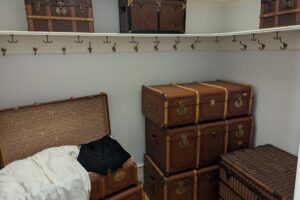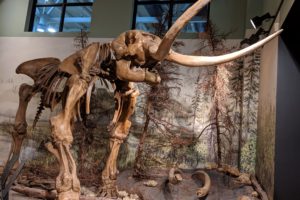Since as seniors we’re still in a “be careful” phase of Covid-19, we decided to spend a couple of months exploring Georgia, especially the state parks, and choose the city of Albany in the southwest corner of Georgia as our first destination.

You are probably wondering why we chose this city; good question. When we first got to Georgia in the early 2000s, two Christian movies were playing that really peaked our interest: Facing the Giants and Fireproof. When we read that they were filmed by a church family in Albany, we decided that we wanted to visit the city that produced these films (as well as Flywheel and Courageous).

original building 
new worship center
Now that we’ve accomplished our original goal of coming to Albany, we had to figure out what else was interesting in this area. If you don’t like reading details, scroll through the history to the pictures of places we found. Much of this information is from Wikipedia; thank you!
Overview: Albany today is the 10th largest city in Georgia with over 75,000 people, even larger than Alpharetta where we live. Of course after driving past Albany’s city limits, we were in farm land, which isn’t true in Alpharetta. Nelson Tift, a northerner, founded the city, naming it after the capital of New York with the hope that it would become a commercial business center like its namesake. Albany was incorporated in 1838, and is currently the only incorporated city/town in Dougherty County, which means it has received its charter from the state.
founder: For decades, Tift was the city’s leading entrepreneur. An enthusiastic booster, he promoted education, business, and railroad construction. During the Civil War he provided naval supplies and helped build 2 ships for the South. After the war, he opposed the changes that the northerners wanted to make and was scornful of the Yankee carpetbaggers who came south. One historian, John Fair, concludes that Tift became “more Southern than many natives.” His pro-slavery attitudes before the war and his support for segregation afterward made him compatible with Georgia’s white elite.
Flint River: A highlight of the city is the 334-mile Flint River that flows through downtown Albany. This river starts around the Atlanta airport area and joins up with the Chattahoochee River at the Florida state line where it joins the Apalachicola River to end up at the Gulf of Mexico. (We’ll be visiting this area where the 2 rivers meet on our next state park trip.)
Margaret Mitchell mentioned this river as one of Tara’s boundaries in Gone With the Wind. Country music singer Luke Bryan references the river in his songs “That’s My Kind of Night,” Huntin’, Fishin’ & Lovin’ Every Day,” and “We Rode in Trucks.” Guess we need to listen more closely to his lyrics.
early inhabitants: The region where Albany is located was long inhabited by the Creek Indians, who named the area after their word for “flint,” the mineral found in beds near the Flint River. They used this hard mineral for arrowheads and other tools. In 1830 Congress passed the Indian Removal Act that forced the native peoples to lands west of the Mississippi River and began the first change to the city that reinvents itself.
travel on the river: Of course any long waterway means commercial travel can happen. Albany became prominent in the 19th century as a shipping and market center, first served by riverboats and steamboats that connected the city with Apalachicola, Florida. Later on, these boats were replaced by railroads in the mid 19th century, and 7 rail lines met in Albany, making it was a center of trade in the Southeast. This area is now part of the Deep South of cotton plantations. Another opportunity for the city to reinvent itself.
growth from the military: During the mid-20th century, Albany received military investment beginning with WW2 and after the war that helped develop the region. A U.S. Army Air Corps training base was built after WWI near Albany on land owned by the city and leased to the Air Corps for $1 a year. Next, construction of the base and airfield by the Army Corps of Engineers began on March 25, 1941. After WWII, the airfield was temporarily deactivated between August 15, 1946, and September 1, 1947.
After the beginning of the Cold War and the founding of the U.S. Air Force in late 1947, the airfield was reactivated and upgraded with runways for a U.S. Air Force base and was named Turner Air Force Base. The Air Force used this base for heavy bomber jets, such as the B-52, and other Air Force units, that specialized in photomapping, refueling, and maintenance functions.
In 1951, the U.S. Marine Corps established a logistics base on the eastern outskirts of Albany. During the 1950s and 1960s, so many white servicemen and associated workers arrived that the city briefly became majority white for the first time since 1870.

The primary mission of the units on the base is to rebuild and repair ground combat and combat support equipment and to support installations on the East Coast of the United States. This location was chosen because it was accessible to the Gulf of Mexico and the Atlantic Ocean and could be serviced by road and rail. Albany was also attractive for 2 reasons: its inland location that was away from the possibility of saltwater corrosion of the stored equipment, and its adequate workforce.

The base is on more than 3,300 acres and in 2002 employed more than 2,400 civilians, along with 600 Marines.

In 1967, the Air Force closed all its operations at the base, transferring them to the U.S. Navy and renaming the base as Naval Air Station Albany. NAS Albany was used as the shore base of nearly all the Navy’s RA-5C Vigilante twin-jet, carrier-based reconnaissance aircraft. In 1974, the base was closed and the property was returned to the city. In 1979, the Miller Brewing Company purchased part of the old naval base’s property to build a new brewery. More reinventing.
civil rights era: Albany and this area were prominent during the civil rights era, particularly during the early 1960s when activists worked to regain voting and other civil rights. Railroad restructuring and reduction in the military here caused job losses, but the city has developed new businesses. More reinventing.
businesses today: We were amazed with the businesses we saw as we drove around. A Proctor & Gamble plant was next to our campground; it produces toilet paper so the grocery stores were well stock with paper goods. The plant’s 2020 claim-to-fame is that it was one of the two locations for Covid-19 outbreaks in Albany.

Other businesses are MillerCoors, Mars Chocolate North America, Phoebe Putney Memorial Hospital, a well known teaching hospital with a cancer center. Albany State University and Albany Technical College support higher education in this part of Georgia.
As we were driving home from the Marine Corps Logistics Base through the flat countryside, we saw row after row of solar panels, so many rows that the field looked like a solar farm.
Sure enough, a number of these solar farms have been built on land that used to grow cotton and now provides electricity to Georgia Power. You may want to look for pictures of these solar farms.
Outside of town is the Albany Airport that provides air service for the county.

Flight training was done at the airfield during WWII. Today 6 airlines fly into the city: American Airlines, Cape Air, Delta Air Lines, Jet Blue, Southwest Airlines, and United Airlines.
Riverfront Park

So many places to visit if only they were open. Oh well, maybe next time.



pathway 
view of the river
On this day we walked 20 minutes (about 1 mile for us), turned around, and walked back.
Another day we decided to go back down to the river walk and turn right at the Ray Charles statue.

The walkways around the statue are designed as piano keyboards!
After turning right, we came to the boardwalk that kayakers could use to get to the river.

We had planned on walking our 20-minute mile like we had previously done, but instead we only walked about half a mile until we came to the amphitheater at the end of the pathway.

Radium Springs
In the southeast part of city is Radium Springs, the site of one of the “Seven Natural Wonders of Georgia,” the largest natural spring in the state.

The deep blue waters of Radium Springs flow at 70,000 gallons per minute and empty into the Flint River. Divers enjoy the extensive underwater cavern system. The water contains trace amounts of radium (a chemical element on the periodic table), and the water temperature is 68 degrees Fahrenheit year round. Before radium was found in the water in 1925, the site was known as “Blue Springs.”
In the 1920s, a casino was built overlooking the springs and the town became a popular medicinal spa and resort. Northerners traveling by train to winter in Florida often stopped to swim in the springs, which were thought at the time to be healthful because of the radium content. The casino was severely damaged when the river flooded in 1994, and again in 1998, and was demolished in 2003.

Since the springs were closed, I couldn’t get a picture of what they look like today, and I wondered what they and the casino area looked like back in the 1920s. Found some fascinating pictures that you may want to look for.


Of course, every site we visit has a board with information on it about what we’re seeing.




7 natural wonders of Georgia: I bet you’ve been wondering what the other natural wonders of Georgia are. Here you go: Amicalola Falls State Park, Okefenokee Swamp, Providence Canyon, Radium Springs, Stone Mountain, Tallulah Gorge, and Warm Springs. As of today, we’ve been to all of these spots!
historical downtown (closed)
Remember when we saw this sign when we started to walk down to the river walk?

Now we’re at the end of the “other” path and can at least see what the history museum looks like.



breakfast “out”
The first day we were in Albany we called the visitors center (closed) and spoke with the nicest lady. We asked about restaurants she would recommend in case we wanted to eat “out,” and then we asked about breakfast places. Without taking a breath, she said we had to go to Pearly’s for their biscuits—the best in town, she said.

While we waited, the cars in the drive-thru never stopped coming.

Now for breakfast:

campground
Our campground for this visit was a commercial one. What we’ve found in many smaller towns is that people live in these campgrounds full-time instead of finding more expensive housing in the city/town. This seemed to be true of this campground, but the people we saw (not many) were friendly, and the campground was well cared for.


campsite 
gazebo and pond
We really enjoyed our stay in Albany and may come back when places here are open. Now on to our next stop at a Georgia state park.














